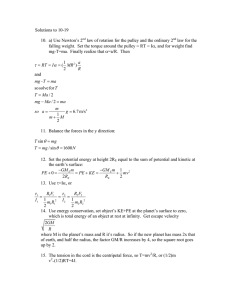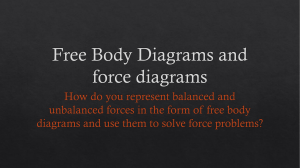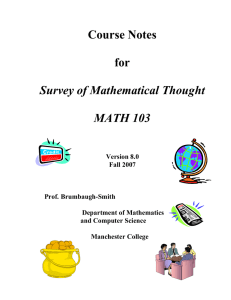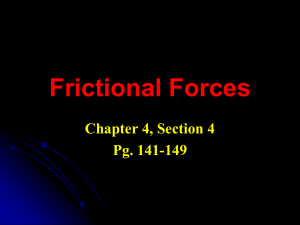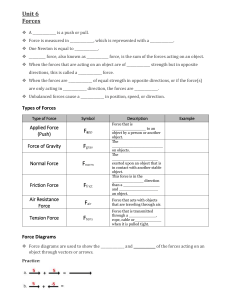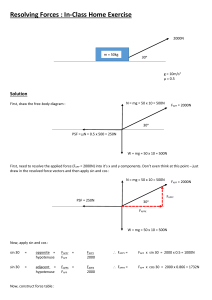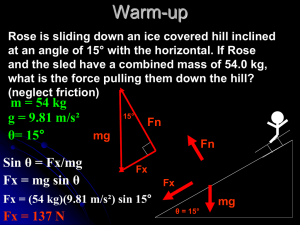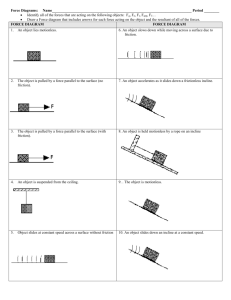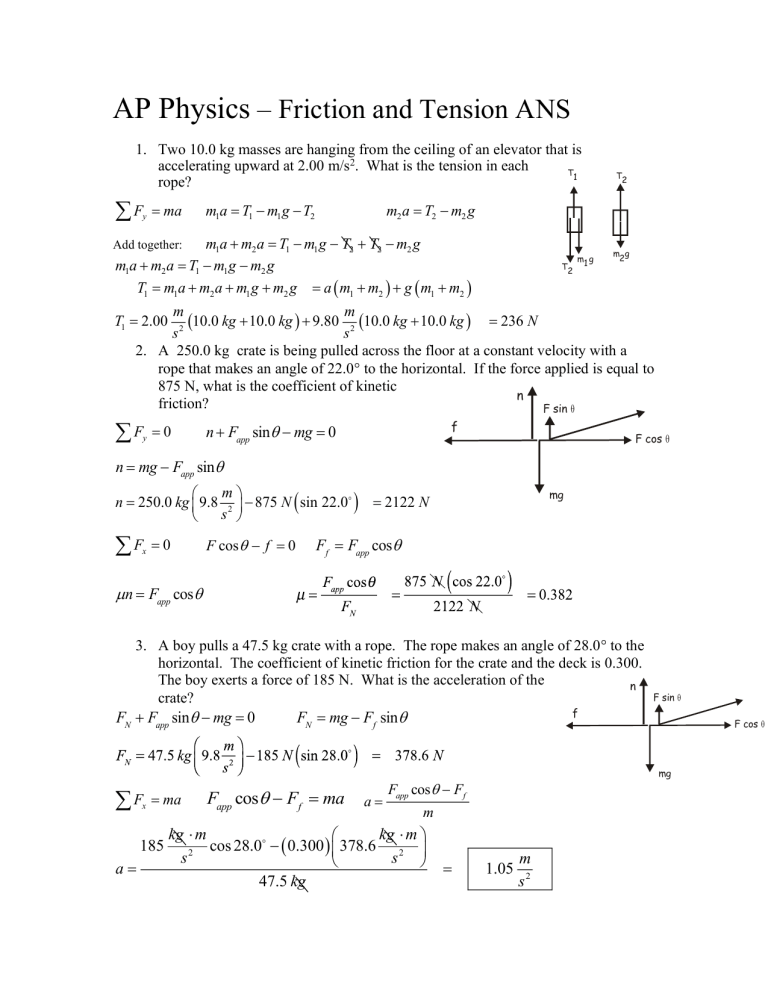
AP Physics – Friction and Tension ANS 1. Two 10.0 kg masses are hanging from the ceiling of an elevator that is accelerating upward at 2.00 m/s2. What is the tension in each T1 rope? F y = ma T2 m2 a = T2 − m2 g m1a = T1 − m1 g − T2 m1a + m2 a = T1 − m1 g − T2 + T2 − m2 g m1a + m2 a = T1 − m1 g − m2 g T1 = m1a + m2 a + m1 g + m2 g = a ( m1 + m2 ) + g ( m1 + m2 ) Add together: T2 m g 1 m g 2 m m 10.0 kg + 10.0 kg ) + 9.80 2 (10.0 kg + 10.0 kg ) = 236 N 2 ( s s 2. A 250.0 kg crate is being pulled across the floor at a constant velocity with a rope that makes an angle of 22.0 to the horizontal. If the force applied is equal to 875 N, what is the coefficient of kinetic n friction? F sin T1 = 2.00 F y =0 f n + Fapp sinq - mg = 0 F cos n = mg - Fapp sinq m n = 250.0 kg 9.8 2 − 875 N ( sin 22.0 s F x =0 F cos − f = 0 ) mg = 2122 N Ff = Fapp cosq mn = Fapp cosq 3. A boy pulls a 47.5 kg crate with a rope. The rope makes an angle of 28.0 to the horizontal. The coefficient of kinetic friction for the crate and the deck is 0.300. The boy exerts a force of 185 N. What is the acceleration of the n crate? FN + Fapp sinq - mg = 0 F x = ma 185 a= FN = mg - Ff sinq Fapp cosq - Ff = ma a= F sin f mg Fapp cosq - Ff m kg m kg m cos 28.0 − ( 0.300 ) 378.6 2 2 s s 47.5 kg = F cos 1.05 m s2 4. Two small blocks, each of mass m, are connected by a string of constant length 4 h and negligible mass. Block A is placed on a smooth tabletop as shown, and block B hangs over the edge of the table. The tabletop is a distance 2 h above the floor. Block B is then released from rest at a distance h above the floor at time t = 0. (a) Determine the acceleration of block B as it descends. (b) Block B strikes the floor and does not bounce. Determine the time A m t1 at which block B strikes the floor. (c) Describe the motion of block A from time t = 0 to the time when block B strikes the floor. (d) Describe the motion of block A from the time block B strikes the floor to the time block A leaves the table. (e) Determine the distance between the landing points of the two blocks. (a) Block B: ma = mg − T Acceleration is the same n ma + ma = mg − T + T 1 2 at 2 a+a = g 2y a 2a = g 2h 4h = g g 2 (c) Accelerate at g/2 till block B hits the deck (b) y = t= = (a) Moves at constant speed till it falls off table g (b) v 2 = vo 2 + 2ay v = 2ay = 2 h = 2 y= 1 2 at 2 x = vt t= 2y a = 2 ( 2h ) g 4h 4 gh 2 = gh = g g = = 2 mg mg h g gh 4h g = 4h 2 = 2h 5. Two masses are connected by a light string which passes over a frictionless pulley as shown. (a) What is the acceleration of the system? (b) What are the tensions in the string? m2 a = T − m2 g (a) m1a = m1 g − T T T Add ‘em up: m1a + m2 a = T + m1 g − m2 g − T m1a + m2 a = m1 g − m2 g 2h h T g 2 a= B m T ma = T Block A: 3h a ( m1 + m2 ) = g ( m1 − m2 ) 5.00 kg 5.25 kg m1 g m2 g a= g ( m1 − m2 ) ( m1 + m2 ) = 9.8 m 5.25 kg − 5.00 kg s 2 5.25 kg + 5.00 kg = 0.239 m s2 (b) m1a = m1 g − T m m T = m1 g − m1a = 5.25 kg 9.8 2 − 5.25 kg 0.239 2 = s s 50.2 N 6. You pull on a 98.0 kg bag of wild bird seed and drag it across the deck. If the coefficient of friction for the bag on the deck is 0.445, what force must you apply to move the thing at a constant speed? æ mö F = Ff = m FN = m mg = 0.445 98.0 kg ç 9.8 2 ÷ = 427 N è s ø ( ) n f T mg 7. A retired policewoman pushes on a 77.2 kg crate with a pole. The pole makes an angle of 32.0 to the horizontal. The coefficient of friction for the crate and the deck is 0.350. The policewoman exerts a force of 535 N. What is the acceleration of the crate? Fx = ma F y =0 ma = Fapp cosq - Ff a= FN - Fapp sinq - mg = 0 m FN = Fapp sinq + mg æ mö Fn = 535 N sin32.00 + 77.2 kg ç 9.8 2 ÷ = 1040 N è s ø Ff = uFN = (0.350)(1040 N ) = 364N Fnet = Fapp - Ff = ma ; a = Fapp - Ff m n Fapp cosq - Ff = 2.22m / s 2 F f mg
